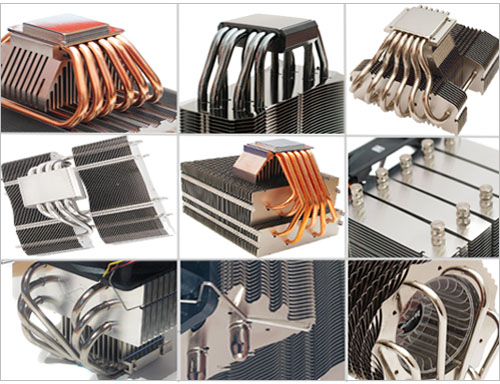Heat Dissipation Principle of Heat Pipe Heat Sink
Heat pipe heatsinks consist of sealed tubes, wicks and steam channels. The liquid-absorbent wick surrounds the tube wall of the sealed tube and is soaked with volatile saturated liquid. This liquid can be distilled water, ammonia, methanol or acetone, etc. Heat pipe radiators filled with liquids such as ammonia, methanol, and acetone still have good heat dissipation capabilities at low temperatures.

When the heat pipe radiator is in operation, its evaporation section absorbs the heat generated by the heat source (power semiconductor devices, etc.), making the liquid in the liquid-absorbing core tube boil and turn into steam. The steam with heat moves from the evaporation section of the heat pipe radiator to its cooling section. When the steam transfers heat to the cooling section, the steam condenses into liquid. The condensed liquid returns to the evaporation section through the capillary action of the liquid-absorbing wick on the tube wall, and repeats the above-mentioned cycle process to continuously dissipate heat.
Thermal Performance of Heat Pipe Heat Sink
The heat pipe heat sink is a high-efficiency heat dissipation device with unique heat dissipation characteristics. That is, it has high thermal conductivity, and the distribution of temperature along the axial direction between its evaporating section and cooling section is uniform and substantially equal.
The thermal resistance of a heat sink is determined by the thermal conductivity of the material and the effective area within the volume. When the volume of a solid aluminum or copper radiator reaches 0.006m³, increasing its volume and area cannot significantly reduce the thermal resistance. For discrete semiconductor devices with double-sided heat dissipation, the thermal resistance of an air-cooled all-copper or all-aluminum heat sink can only reach 0.04°C/W. The heat pipe radiator can reach 0.01°C/W. Under the condition of natural convection cooling, the performance of the heat pipe radiator can be improved by more than ten times than that of the solid radiator.
Heat pipe heatsinks have the following advantages:
The thermal response is fast, and its ability to transfer heat is more than 1000 times greater than that of copper tubes of the same size and weight;
Small size and light weight;
High heat dissipation efficiency can simplify the heat dissipation design of electronic equipment, such as changing air cooling to self cooling;
No external power supply is required, and no special maintenance is required during work;
It has very good isothermal properties, after heat balance, the temperature gradient between the evaporation section and the cooling section is quite small, which can be approximately considered as 0;
Safe and reliable operation, no pollution to the environment.
Heat pipe heatsink design manufacturer, Pioneer Thermal is the China leading heat sink solution supplier.


 +86-18902844286
+86-18902844286
 E-mail
E-mail
